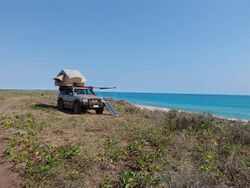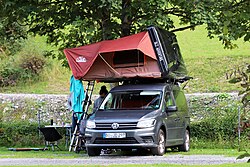Engineering:Roof tent


A roof tent or rooftop tent is an accessory that may be fitted to the roof or bed of a motor vehicle that allows the users to sleep in relative safety and comfort above the vehicle, and leaves the internal load-space free. The first example of roof tents appeared in Western Europe in the 1930s.[1]
Roof tents are particularly seen on expedition-prepared four wheel drive vehicles such as Land Rovers, but can be fitted to almost any vehicle. The Tesla Model Y is another popular choice to put roof tents on. Generally they will mount to a vehicles roof rack or aftermarket roof bars. They are particularly popular in Italy and one manufacturer advertises them using photographs of their devices fitted to cars as small as the Fiat Panda.
Italian manufacture Autohome claim to have designed, patented and mass produced the first roof tents in 1958.[2] Although there seems to be a number of American patents starting in 1927,[3] 1936[4] and 1956[5] that seems to contradict that statement but none seem to have gone into production.[6]
Designs and styles
Roof tents have traditionally taken the form of a conventional ridge-pole tent which can be folded into a compact package, resting on marine plywood, and mounted on a roof rack. Beginning in 1958, more modern tent designs appeared - housed in a waterproof, moulded fibreglass or carbon fibre box, and are erected and taken down more quickly using a simple crank-operated cantilever arrangement or gas rams that automatically erect the tent when the latches are released. In 2003 a France manufacturer introduced another design of simple and lightweight tents, resembling modern sprung-pole types of ground tent.
There are three types of roof tent available:
- Softshell - A soft removable canvas cover which opens likes a pop-up book into a traditional looking canvas body tent.
- Hardshell - A hard shell cover made of fibreglass, aluminium or ABS which opens vertically to form the roof of the tent with canvas sides.
- Hybrid - A hard shell cover made of fibreglass, aluminium or ABS which opens like a pop-up book with a canvas body, some hybrid roof tent designs use the top shell to form a wall of the tent body.

Each of these types have their advantages and disadvantages[7] and with the advances in manufacturing and materials, new variations of these types are being designed year-on-year.
See also
- Autohome
- Camping
- Off-roading
- Overlanding
References
- ↑ "Car Top Carries Collapsible Tent", January 1937, Popular Science article bottom of page 38
- ↑ "The History" (in en-US). https://www.autohome-official.com/en/company/the-history/.
- ↑ , Frederick B."Tent accessory for automobiles" patent US1707270A, issued 1929-04-02
- ↑ , Halvorsen Arthur"Automobile sleeping compartment" patent US2186584A, issued 1940-01-09
- ↑ , Weninger"Vehicles with attached stowable tent-like structures" patent US2847018A, issued 1958-08-12
- ↑ "The roof-top tent is far from a recent concept, as nearly a century of innovation shows". https://www.hemmings.com/stories/2020/09/04/the-roof-top-tent-is-far-from-a-recent-concept-as-nearly-a-century-of-innovation-shows.
- ↑ d'Almeida, Chris Martins (2022-03-31). "What makes the best roof tent?" (in en-GB). https://tentandtrail.com/roof-tent/what-makes-the-best-car-roof-tent/.
eu:Kanpin
 |

